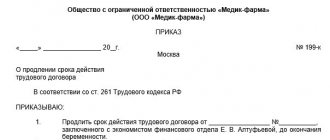As a general rule, the employer is obliged to enter into open-ended employment contracts with employees. An employee needs stability to support his family, pay a mortgage and grow professionally in one job. They hired a person, and he works until retirement or successful headhunting of competitors.
But organizations often have a reasonable business need to hire a temporary employee. The Labor Code of the Russian Federation takes this need into account: in specific cases, fixed-term employment contracts can be concluded with employees.
In this article, we explained for what reasons employers have the right to hire and fire temporary workers. A bonus is how to avoid making popular mistakes that cause entrepreneurs to lose money on fines and payments to employees.
Employment contract
Kurgan
May 4, 2023
We: PJSC "Kurgan Machine-Building Plant", hereinafter referred to as the Employer, represented by General Director Vladimir Afanasyevich Ustinov, acting on the basis of the Charter on the one hand, and Vitaly Mikhailovich Kopylov, hereinafter referred to as the Employee, on the other hand, have entered into this agreement as follows:
An open-ended employment contract is considered concluded if the Counterparties reach an agreement on the following essential conditions:
What are the requirements for a framework agreement?
The Civil Code of the Russian Federation contains only general requirements for a framework agreement. The parties have the right to determine all the rules and conditions in the document themselves. An agreement falls under the concept of a framework agreement if it specifies the general outlines of the agreement: it may not contain the names of goods or services or the amount of the agreement. In the future, the general conditions are subject to clarification and reinforcement using annexes to the contract (specifications); the parties sign them when the need for supply arises. The amount of such an agreement is the sum of all applications.
But do not confuse a framework agreement with a preliminary agreement. Under a preliminary agreement, the parties are obligated to sign an agreement in the future on the terms and conditions specified in the preliminary agreement. And if a framework agreement is concluded, in the future the parties only clarify the specific conditions using appendices to the agreement.
Item
Information about the subject includes provisions such as:
- position held by the employee;
- specifics of the work, i.e. type of activity of the employee;
- address of the institution where the employee is employed.
Data about the subject appears in the clauses of this agreement as follows:
1. Under this Employment Agreement, the Employer provides the Employee with work. Position - Design engineer for serial products. In accordance with this Agreement, the Employee undertakes to fulfill his job duties within the framework of the terms of this Agreement. The place of performance of the Employee’s labor duties is workshop No. 4 of PJSC Kurgan Machine-Building Plant, which is located at the address: Kurgan region, Kurgan, Mashinostroiteley Avenue 107A. The Employee’s labor activity under this Agreement is carried out under normal conditions and is his main job.
Dangerous moments
Concluding fixed-term employment contracts instead of open-ended ones in order to evade providing employees with their rights and guarantees is directly prohibited by Article 58 of the Labor Code.
An employment contract concluded for a certain period in the absence of sufficient grounds established by the court is considered concluded for an indefinite period (Article 58 of the Labor Code of the Russian Federation).
If the court reclassifies employment contracts as open-ended, then in addition to all required payments to employees (reinstatement at work, payment for forced absence, moral damage, etc.), they will have to pay a fine (Article 5.27 of the Code of Administrative Offenses of the Russian Federation). Its amount for officials is 1000–5000 rubles, for legal entities – 30,000–50,000 rubles. Moreover, the court can suspend your activities for up to three months.
To prevent this from happening, you need to pay special attention to the correct and timely documentation of labor relations with employees, as well as proper registration. The document must contain all the necessary details: date, number, signature, etc. Let’s list a few key points.
If the court reclassifies employment contracts as open-ended, then in addition to all required payments to employees (reinstatement at work, payment for forced absence, moral damage, etc.), they will have to pay a fine (Article 5.27 of the Code of Administrative Offenses of the Russian Federation).
The contract must be concluded for a certain period. In the event of a trial, you will have to prove that the employment contract could not have been concluded for an indefinite period. This obligation of the employer is enshrined in Article 56 of the Civil Procedure Code. If you cannot prove this, then a fixed-term employment contract can be reclassified as an indefinite one. This is due to the fact that Article 59 of the Labor Code lists cases in which the employer has the right, and not the obligation, to enter into a fixed-term employment contract. He can exercise this right only by complying with all the requirements of Article 58 of the Labor Code.
You cannot conclude several fixed-term employment contracts in a row with the same employee to perform the same job function. If it is established that the same employee has repeatedly concluded short-term fixed-term employment contracts to perform the same job function, the court has the right to recognize the employment contract as indefinite (clause 14 of the resolution of the Plenum of the Supreme Court of the Russian Federation of March 17, 2004 No. 2).
A fixed-term employment contract concluded by agreement of the parties can also be recognized as indefinite. This will happen if the court decides that workers were forced to enter into fixed-term employment contracts.
Another dangerous point is the expiration of the employment contract. If a person continues to work and the employer does not require termination of the contract, then it is considered concluded for an indefinite period (Article 58 of the Labor Code of the Russian Federation). Therefore, you need to carefully monitor the expiration of employment contracts and formalize everything correctly.
Let's calculate vacation pay
A fixed-term employee has the same right to annual paid leave as an employee under an open-ended employment contract. Based on Article 114 of the Labor Code, he is generally granted annual paid leave while maintaining his job and salary. The duration of leave for “indefinite-term” employees should not be less than 28 calendar days per year (Article 115 of the Labor Code of the Russian Federation). If a person is signed under a fixed-term employment contract, vacation pay is calculated differently; the duration of his vacation directly depends on the number of days worked.
Thus, according to Article 295 of the Labor Code, employees who have entered into fixed-term employment contracts for a period of less than two months or perform seasonal work are granted leave in the amount of two working days for each month of work.
Employees who have entered into fixed-term employment contracts for a period of less than two months or perform seasonal work are granted leave in the amount of two working days for each month of work (Article 295 of the Labor Code of the Russian Federation).
Please note: the right to use vacation for the first year of work arises for an employee only after six months of continuous work with one employer (Article 122 of the Labor Code of the Russian Federation).
The amount of vacation pay for an employee registered under a fixed-term employment contract depends on the amount of his average salary. The rules for calculating average wages are uniform and are established in Article 139 of the Labor Code and in the Regulations on the specifics of the procedure for calculating average wages, approved by Decree of the Government of the Russian Federation of December 24, 2007 No. 922.
Regardless of the mode of work, the average salary is calculated based on the salary actually accrued to the employee and the time actually worked by him for the 12 calendar months preceding the period during which the employee retains the average salary. The calendar month for calculation is considered to be the period from the 1st to the 30th (31st) day of the corresponding month inclusive (clause 4 of the Regulations on the specifics of the procedure for calculating average wages).
The amount of average earnings is equal to the product of the average daily earnings by the number of days in the period subject to payment.
To calculate the average daily earnings for vacation pay in calendar days and payment of compensation for unused vacations, you need to divide the amount of wages actually accrued for the billing period by 12 and by the average monthly number of calendar days (29.4).
An employee can take leave at his own expense in the general manner on the basis of a written application (Article 128 of the Labor Code of the Russian Federation).
Often the vacation time extends beyond the term of the employment contract, and the employee is granted vacation with subsequent dismissal, then the employee’s last working day will be the last day of his vacation. At the same time, the employment contract is not recognized as indefinite, because the rule to consider the last vacation day as the day of dismissal is established by Article 127 of the Labor Code.
Example
A travel company entered into an employment contract for a period of six months with a swimming instructor Lastov with a salary of 30,000 rubles. per month. Lastov taught tourists to scuba dive six days a week from April 1 to September 30, 2010 inclusive. Let's calculate the amount of vacation pay for a seasonal employee.Lastov worked fully for six months, the duration of his vacation will be:
6 months x 2 days/month = 12 days
The amount of accrued wages will be:
30,000 rub./month. x 6 months = 180,000 rub.
The number of working days will be:
26 in April + 24 in May + 25 in June + 27 in July + 26 in August + 26 in September = 154 days.
Average daily earnings will be:
180,000 rub. : 154 days = 1168.83 rub./day.
The amount of vacation pay will be:
RUB 1,168.83/day x 12 days = 14,025.96 rub.
Contract term
In our case, the period is indefinite, therefore, in the clauses of the contract it is stated “for an indefinite period.” This paragraph also indicates the date from which the citizen begins his work duties:
This employment contract is concluded for an indefinite period and comes into force from the moment of its signing. The Employee’s start date for performing his work duties is May 4, 2023. The probationary period is 14 (Fourteen) calendar days.
What law governs the framework agreement?
The framework agreement appeared in 2015 and is regulated by Article 429.1 of the Civil Code.
Before this, a similar agreement was applied, but was called an organizational agreement, which determined the general features of the future full-fledged agreement. The framework is subject to the principles of civil law on freedom of contract, the validity of the contract, and the requirements for the form of concluding the contract. The parties enter into it free of charge, and property obligations will appear in subsequent agreements.
Rights and obligations of the parties
This section of this agreement specifies information about the obligations of the Employee and the Employer under this agreement. Often the following formulations are given:
The employee undertakes: - to perform work in accordance with the instructions of his immediate supervisor. The work must be completed efficiently and within the specified time frame. — observe labor discipline in accordance with the Charter of the enterprise; — conscientious attitude to the performance of their labor duties within the framework of this agreement; — treat with care the property entrusted by the enterprise for the performance of labor duties; — comply with safety precautions, sanitary and hygienic prevention, labor protection requirements. The Employer undertakes: - to provide work for the Employee under this agreement; — make payments in accordance with this Agreement; — ensure normal (safe) working conditions for the Employee, provided for by labor legislation; — maintain the Employee’s work book, entering information into it; The employee has the right: - to demand the fulfillment of obligations by the employer under the employment contract and labor legislation. The Employer has the right: - to demand high-quality performance of obligations by the Employee under this agreement; — reward and encourage the employee in case of high-quality, conscientious fulfillment of obligations; - bring to material and disciplinary liability.
How to draw up a framework agreement
Include as many important things as possible in the frame. To avoid problems, formulate in the framework agreement the important conditions that were agreed upon: sanctions for failure to deliver and failure to meet deadlines, acceptance rules, methods of determining the price, the right to unilaterally withdraw from the contract, the procedure for filing claims. Then, in the annex to the contract, it remains to specify the specifics: assortment items, number of deliveries and their terms, payment terms, prices.
Ensure cooperation. The framework does not guarantee the conclusion of applications. And if the counterparty refuses to cooperate, he cannot be forced to do so, as is the case with a preliminary agreement.
To avoid such situations, negotiate the framework agreement carefully. For example, include a clause that the supplier must accept all bids from the buyer within certain amounts. Or, conversely, the buyer undertakes to accept all goods of proper quality from the supplier.
Don't forget about apps. Carefully draw up annexes to the contract. Often the parties carefully agree on the terms of the framework agreement, but during the next delivery they forget to draw up a specification, which in essence becomes the main agreement. And then, in case of violations by one of the parties, there will simply be no basis to hold it accountable.
Flaws in the design of the framework and applications can also lead to difficulties.
Establish a connection between the framework and the applications. Write in the frame the name of the documents in which you and the other party will establish the missing terms of the contract: application, specification, application, supply agreement. Please note: some documents require signatures of two parties (supply agreement), while some remain one-sided (application, offer). When drawing up specific documents, make sure that the name strictly corresponds to that specified in the framework agreement, and also state in each application that it forms part of the framework agreement.
Working days schedule
This paragraph indicates the specific schedule according to which the employee carries out his work activities, as well as the vacation schedule. In the text of the document, such a section is composed as follows:
The employee undertakes to perform work in accordance with the working time schedule. By virtue of this agreement, the working week includes 40 (Forty) hours of working time. The employee has the right to rest, and the Employer undertakes to provide this time. The employee has the right to paid leave, and the Employer undertakes to provide it in accordance with labor legislation.
Valid for less than two months or for a season
A situation may arise in which an institution must perform work of a temporary or non-core nature, and there is no need to enter into permanent agreements. In this case, the employer invites employees for up to 2 months or for a season.
Personnel officers of such an organization should conduct a preventive check of the qualifications of citizens hired for this job, since, in accordance with Art. 289 of the Labor Code of the Russian Federation, testing for these categories is not established.
An employee hired to work enters into an employment agreement with the employer. Next, the employer issues a local administrative act, which provides for an exact period of validity - up to 2 months.
If an employee is again hired to work under similar conditions with the same employer, such employment, regardless of the duration of the break, is processed as with a new employee, without taking into account the previous contract. HR specialists must carefully monitor the fact of timely issuance of an administrative document on termination of the contract at the end of the temporary activity. If an order is issued late, in accordance with Art. 58 of the Labor Code of the Russian Federation, this document is transformed into an indefinite one, since the parties did not require its termination upon expiration and the employee continues to work.
Salary
The section on wages records the amount of the employee’s salary:
The employer undertakes to pay monetary remuneration for the employee’s fulfillment of his obligations under this agreement in accordance with labor legislation and other regulations. The amount of monetary remuneration (salary) according to this agreement is 56,000 (Fifty-six) thousand rubles 00 kopecks. Payment of wages is carried out in non-cash form by transferring the amount of money to the Employee’s bank card.
What happens when the framework is terminated
The contract ceases to be valid if there is a refusal to renew it or upon termination - and then rely on the rules for termination of the Civil Code of the Russian Federation.
Termination of the framework does not relieve the parties of existing obligations under transactions that are enshrined in the annexes to the framework. The main framework agreement and the specifications for it are independent contracts, so termination of the framework does not entail termination of the specifications, but only releases the parties from the obligation to enter into future transactions on the terms of the framework and with reference to it.
Record agreements, keep records and submit reports in the Kontur.Accounting web service. The service will save you from routine: most operations are automated. You will never forget to pay taxes on time, easily pay salaries to employees and generate reports in a few clicks. All newcomers work in the service for free for the first 14 days.
Responsibility of the parties
This clause stipulates the liability of the parties towards each other for causing a certain type of damage:
If damage is caused to the organization that provided the work, the Employee undertakes to compensate for this damage in accordance with Labor legislation and other regulations. If damage is caused to the Employee by the organization that provided the workplace, the Employer undertakes to compensate for this damage in accordance with Labor legislation and other regulations. Termination of the agreement does not change the fact that one of the parties is released from liability in the event of damage.








